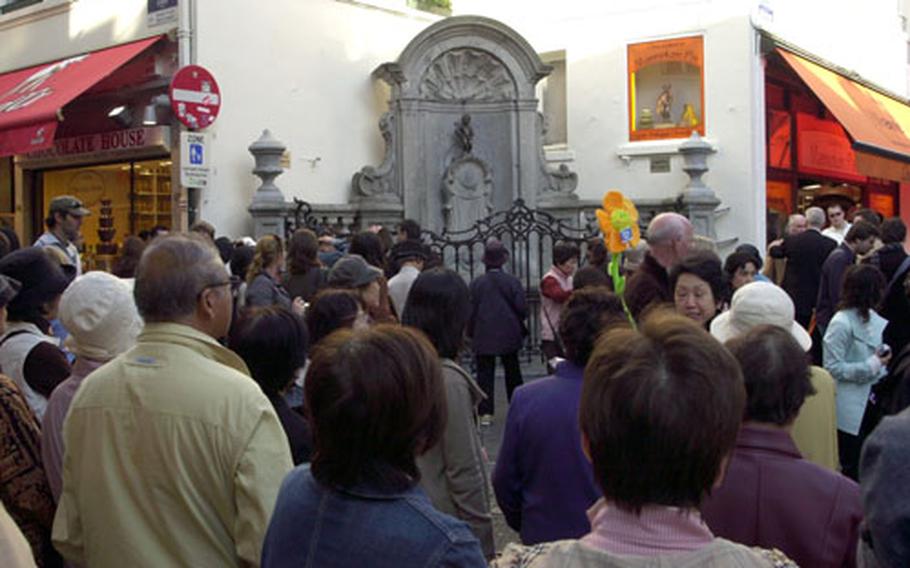
The Manneken Pis is must-see for many tour groups. On some days, you have to fight your way to the fence for a close-up view. (Joseph Giordono / S&S)
When I was a kid, my family lived in Belgium. My father was stationed at SHAPE in the ’80s, and when I wasn’t having nightmares about the Fulda Gap or “The Day After,” we traveled all over Europe.
We scoured the Louvre, attended Easter Mass at the Vatican, gawked in Amsterdam’s red light district and island-hopped through Greece.
So, why is it the most lasting impression I have of Europe at that time is a 24-inch-tall bronze statue of a naked kid peeing on a Brussels street corner? Why, indeed, is the Manneken Pis a landmark that rivals — and for some, even overshadows — the nearby Grand Place?
The thought occurred to me that an 11-year-old kid would naturally be more interested in a urinating fountain than, say, the flying buttresses of the Notre Dame. But to find out for sure, I recently went on a trip back to Brussels. I conned my traveling partner into the trip by tempting her with the usual Belgian enticements: Chocolate! Mussels and fries! Wickedly strong beer and the canals of Brugge!
In reality, there was only one goal: to examine the allure of a slightly cherubic kid, poised with one cocky hand on his hip, the other guiding an eternal stream into the half-shell basin below.
Nobody’s really sure of the Pis’ origin. One legend has it that, centuries ago, a young boy had the misfortune of being caught peeing on a witch’s door. The witch was — understandably — a wee bit upset, and turned the boy into a statue, where he remains.
The most common explanation (and one that is found on a wall plaque near the Pis) is a slightly twisted family story. A man lost his little son in the big city. The man searched high and low, but for two days, his son wasn’t to be found. Then, finally, he found his son — right as the boy was relieving himself on a street corner. So grateful was the man that he commissioned a statue of the boy just as he found him. (The story doesn’t say whether the boy was nude when found.)
According to the Brussels’ city Web site, a version of the Manneken Pis has existed since 1388, when it apparently served as a decoration above a Middle Ages water well. In 1619, the city commissioned sculptor Jerome Duquesnoy to create a new bronze version of the statue to replace the original. And over the course of the following centuries, that little, urinating boy lived through wars, plundering soldiers and even the jealous, thieving citizens of a town called Geraardsbergen, who wanted to cement their claim of having the oldest statue of a peeing boy in Belgium.
The unofficial slogan of the legions of Manneken Pis fans is this: “Be careful! He’s small … but he has no decency!” As the city’s site points out, “The people of Brussels accept him the way he is. After all, it doesn’t have to be big to be beautiful. Imagine [if] he would be the size of the Statue of Liberty…. Brussels would be continuously flooded!”
The Manneken Pis has been hawked in chocolate form, as a corkscrew, on T-shirts, mugs and in every other merchandising trick you can imagine.
But back to the question at hand: Why is the Manneken Pis so popular?
On any given day, at the corner of Rue de l’Etuve and Rue du Chene, crowds gather and gawk. Some days the boy masquerades as Elvis, a jockey, a soldier or in any one of some 600 different costumes (including corporate sponsored theme outfits). On days when his costume is changed, an official society leads a parade from the Grand Place to unveil the new uniform, and the statue pees beer. Yes, beer.
A group of Japanese tourists crowding the black metal fence in front of the statue recently explained the allure this way: “He’s cute.”
A German tourist said, “I was just following the crowd.”
Several others reasoned that “it was in the guidebook.”
Unsatisfied, I asked the bartender of a pub across the street from the statue.
“Look,” he said, “it’s a symbol, a metaphor. It is Brussels. Why question these things? Just enjoy.”
Maybe it was the effects of the Belgian beer, but that seemed a good enough explanation.